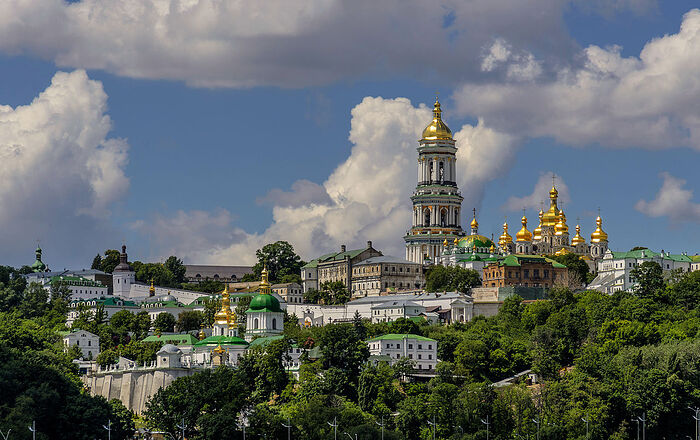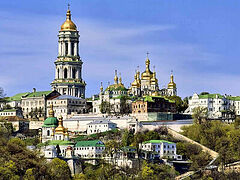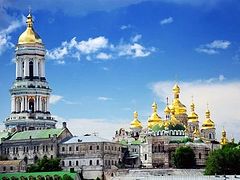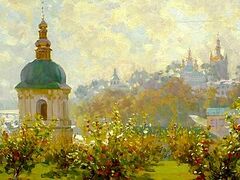Kiev, August 10, 2020
The President of Ukraine Volodymyr Zelensky has confirmed that the canonical Ukrainian Orthodox Church of the Moscow Patriarchate, led by His Beatitude, Metropolitan Onuphry of Kiev and All Ukraine, will remain in their home at the Kiev Caves Lavra, and they will retain free use of the Lavra. The Kiev Caves Lavra is constantly under threats by schismatic and ultra-nationalist groups, who desire to seize the technically government-owned Lavra from the Ukrainian Church, and give it to various schismatic Ukrainian denominations or the Ukrainian Uniates. As the Church legally shares the Lavra with the state, or rather, is permitted by the state to abide therein, the situation is complex, and at times—embattled.
The magnificent Kiev Caves Lavra, founded in the tenth century prior to the Great Schism, was the first Russian monastery, and is considered the birthplace of Russian monastic tradition, and the cradle of the Russian Church along the river Dnieper, where the Baptism of Rus’ in 988 took place. It was long considered to be the greatest of all Russian monasteries, by figures such as Patriarch Macarius of Antioch, who traveled to Ruthenia (modern-day Ukraine) and Moscovy in the seventeenth century. The Kiev Caves are the resting place of the uncorrupt relics of a great host of ancient saints.
In modern Ukraine, the Lavra—a UNESCO World Heritage Site, “national sanctuary”, and “cultural attraction”—is also the headquarters of the Ukrainian Orthodox Church and the official residence of the Metropolitan of Kiev. The Lavra is both physically and legally divided into two portions—the upper and lower Lavra territories—and while both technically belong to the Ukrainian government, the Ukrainian Church is permitted to use and reside there. How this came to be is a complex story.
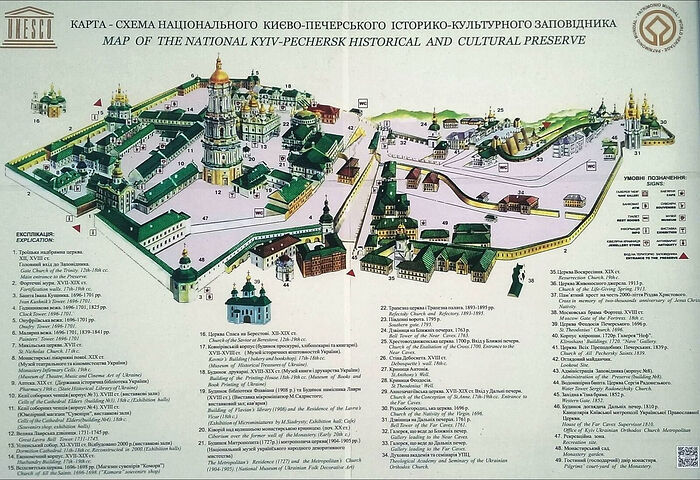 Map of Kiev Caves Lavra, the Upper Lavra on the left, lower on the right. The Upper Lavra is under state control, while the lower, under church control. The state technically owns the entire territory, and the church is permitted to use both under agreements. Photo: http://infoportal.kiev.ua
Map of Kiev Caves Lavra, the Upper Lavra on the left, lower on the right. The Upper Lavra is under state control, while the lower, under church control. The state technically owns the entire territory, and the church is permitted to use both under agreements. Photo: http://infoportal.kiev.ua
In 1988, the millennium of the Baptism of Rus’, the Soviet godless authorities in the Ukrainian SSR allowed the Church to reestablish the monastic community on the territory of the Far Caves in the Lower Lavra and thus begun the re-flowering of ecclesiastical life.
In modern-Ukraine, despite the anti-Soviet rhetoric, practically speaking a similar secular system exists on the foundation of the previous Soviet system, where certain major religious sites like the Kiev Caves Lavra and Pochaev Lavra, as well as Holy Sophia Cathedral (registered as part of the same UNESCO site as Kiev Caves Lavra), are legally in position of the Ukrainian government, which may choose to lease or allow Churches to temporarily or permanently use them. The schismatic OCU, for example, was allowed to use Holy Sophia Cathedral for their “unification council”, and “enthronement ceremony”, as well as their cross procession (with at times include the participation of neo-Nazi elements).
The Kiev Caves Lavra has since the 90s, always effectively belonged to the Ukrainian Orthodox Church in practice, if not in formal legal terms. The Ukrainian Church exercises a more complete control over the Lower Lavra, where the Holy Synod meets, which is also the location of the Kiev Theological Academy and the home of the seminaries and the brotherhood. The Ukrainian Church also freely uses the great cathedrals in the Upper Lavra for regular services, which they coordinate with the government which operates the museums there. The Ukrainian Church freely opens the Lower Lavra, as a monastery, to the all respectful visitors, who may also visit the Upper Lavra, however during hours when there are no services, the state-run museums—not the Church—may charge visitors for entry. The life of the Lavra is divided therefore, into two worlds, the active monastery and seminary with its deep and lively spiritual life, and the state-run museums which operate as cultural, historical, and tourist attractions.
As noted, the Lavra is at times embattled by Ukrainian nationalist and schismatic, non-Orthodox churches, who feel it should not belong, as they see it, to the “Moscow Church”, despite the fact that the ties between the Ukrainian Orthodox Church and the Moscow Patriarchate are purely canonical and spiritual in nature, but the Ukrainian Church is in practice independent from Moscow, which can not interfere in her internal life, according to her charter.
The Kiev Caves Lavra, however, is the most important religious site in Ukraine, and even for those who are not particularly interested in organized religion, it is an incredibly strong spiritual symbol which conveys a great deal of spiritual authority on whomever occupies it. Its value to national history can also not be mistaken, it was also the site of the first Russian Seminary, and the burial ground of not only saints but even royalty, nobility, and statesmen such as Russian Imperial Prime Minister Peter Stolypin. It also contains some of the best examples of Ukrainian baroque architecture. For all these reasons, it is no surprise that literally everyone in Ukraine wants to claim it as their own, and recently, another such political battle began, which resulted in victory for the Church again, with the Ukrainian President confirming their rite to remain there in their home.
On August 6, 2020, the President of Ukraine Volodymyr Zelensky published his response to a major public petition, “№ 22/092966-еп”, entitled “Leave Kiev Caves Lavra in the use of the Ukrainian Orthodox Church” which was posted on the Presidential website and received 25,408 signatures. Despite attempts by nationalist politicians to remove the Church from the Lavra, the Ukrainian president confirmed their legal right to remain there, saying:
“The Cabinet of Ministers of Ukraine is constitutionally recognized as the body entrusted with the management of the state property in accordance with the law (paragraph 5, Article 116)…By the order of the Cabinet of Ministers of Ukraine № 519-р, on July 11, 2013, the buildings and structures on 11 Lavra Street and 15 Lavra Street, were transferred to the free use of the Holy Dormition Kiev-Pechersk Lavra (a male monastery) of the Ukrainian Orthodox Church.”
For now, this puts an end to yet another attempt to seize the Kiev Caves Lavra, however as the political climate is unstable, this may not be the last attempt. It is unfortunate that Ukrainians who consider themselves enemies of the Soviet godless authorities use the same anti-Church laws and legal powers the Soviets themselves established in Kiev, against the Ukrainian Orthodox Church.
However, as a Vicar of the Kiev Metropolia, Archbishop Theodosy (Snigiryov) of Boyarka once said, the “Truth of God” will never be put to shame, and those who keep it will find themselves both on the right side of history, and of eternity.

